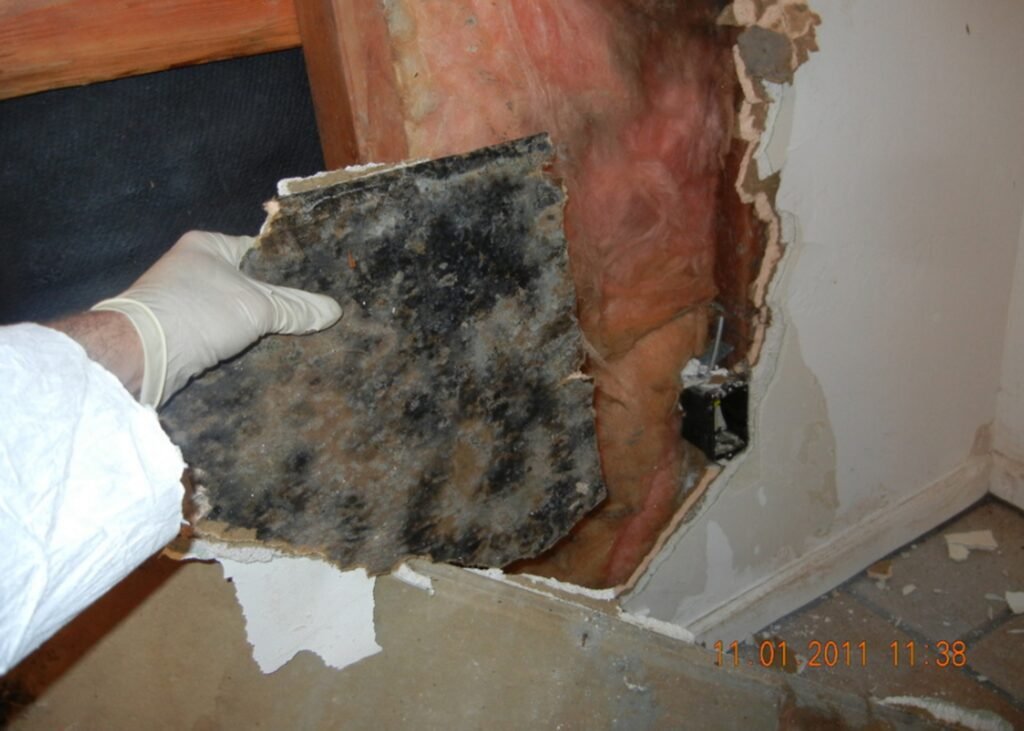There are several types of molds, most of them harmless that have a black coloring that can be mistaken for a more potentially hazardous “black mold”.
By Gold Coast Flood Restorations Santee – See more Home Design Photos
The way to identify if you truly are experiencing a bout of this type of black mold is to take into consideration the various indicators that may be present with your particular case.
You may be able to determine it is not this type of mold if you take a better look at where it is growing.
This type of potentially harmful molds usually only occurs on items that have been wet several times and that contain cellulose. This includes such things as gypsum board, cardboard, ceiling tiles, wood and insulation that contain cellulose. If you find that you have any of these things with black colored mold on them and you can feel a characteristic “musty and mildew”, then your home has been infected by black mold.
Black mold also needs constant moisture to grow, so if you live anywhere with flooding, water infiltration, condensation, water leaks, humidity or water damage, then you are especially prone. If you examine the areas in your residence that may have been recently exposed to moisture, and you find a greenish-black substance that is growing on the walls, floor, or ceiling, then there is a good chance that your home has been infected by black mold.
Black Mold and Your Health:
There is no such thing as toxic mold, though some molds can produce mycotoxins, there is no proof that these molds can actually cause pulmonary hemorrhage or memory loss. However, the majority of mold species can cause minor health problems if they become widespread enough, but with black mold the health consequences can be much more severe with people who may suffer from respiratory problems.
Allergic responses from mold include hay fever-type symptoms, such as sneezing, runny nose, red eyes, and skin rash (dermatitis). Allergic reactions to mold are common and can be lessened as the individual moves out of the contaminated area.
Black Mold Removal:
1/ Diagnosing the Problem
First of all you should determine what is causing the black mold. You need to fix the cause to permanently eradicate the symptom. This means that you need to find out exactly where the mold has grown in your home, and where the moisture is coming from that is feeding it. Once you have determined where the mold is growing exactly, you can then take the necessary steps to remove the moisture problem, and clean up.
- Confirm that the ventilation in your bathrooms and kitchen is working properly and clean it if necessary.
- Avoid carpet in your bathrooms. Carpet in bathrooms is a breeding ground for mold.
- Check if there any areas of your home there are uncharacteristically humid on a regular basis. Check if any water is or pipe leaks that you don’t know about.
- Inspect the drywall, if the drywall is wet, crumbly, or even buckled then it would be best to cut out that section and remove the mold covered drywall and replace it.
- Has your home recently experienced a flood?
2/ Taking Care of the Moisture Issue
This means that you must first do your best to get rid of the moisture problem that is causing the black mold to grow.
- Keep the humidity in your house below 60 percent by using an air conditioner or dehumidifier if necessary. Improve the air circulation, opening windows.
- Wipe down bathroom sinks, tubs, and shower stalls after their use.
- Additionally, use soap scum removers to keep the soap scum (which the mold feeds off of) off the walls.
- If you have leaky plumbing and pipes, then fix them.
- If the drywall is affected and compromised, then remove it.
- If the mold is growing under the base board then remove the baseboard and lift the carpet and check if you have mold growing on the underside of the carpet. If the black mold is in a small area then you should cut that section and replace it.
- If the mold in the carpet is larger than a 2 foot by 2 foot area you should replace the carpet and padding.
- Waterproof the basement. Most black mold removal has to happen in the basement as that is where things are placed, forgotten about and then ruined by a flooded basement.
- If you continually experience the buildup of moisture as a result of a flood or water runoff, perhaps you need to landscape your yard differently, or install a drainage system.
Moldy Drywall Removal | How To Build A House (howtobuildahouseblog.com)
3/ Getting Rid of the Black Mold
First protect yourself with the appropriate cleaning gear and clothing before you decide to follow-through with such a task, as both the black mold, and the cleaning agent that you are using can cause health problems if you do not take the appropriate precautions.
- Goggles, OSHA approved respirator, gloves, plastic, chlorine bleach, bucket, sponge, powder dish washing detergent, tape, clean towels or rags.
-You should first seal off the area that you plan to clean in order to prevent the spread of mold spores throughout the other parts of your home.
– Mix up a solution of one cup of bleach in one gallon of water. Soak a sponge in the solution and wipe the mold off your walls. The bleach should kill the mold. Now there may be some discoloration so you may have to paint the wall. Before you paint the wall make sure it is completely dry.
– Once everything is dry, you must make sure that you remove and discard all of the materials that you used to clean up the mold. This should include all sponges, disposable clothing and protective gear, and anything else that may have been contaminated during the cleaning process.

